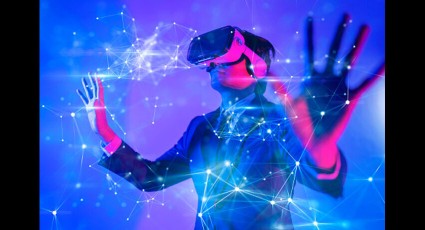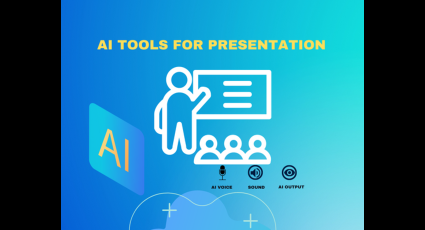Blog Details
How AI Works in Video Editing?

As video content becomes increasingly dominant in the digital space, AI in video editing is not merely revolutionary but a critical element. AI is speeding up the editing process and enabling us to explore the boundaries of creativity. It is changing how we create and consume visual stories across different platforms.
For content creators and businesses, AI in video editing is fascinating and essential for competing and engaging with audiences effectively. This article will unveil the hidden influence of AI in video editing, starting from the ground-breaking technologies that make it possible for practical applications and thrilling prospects.
Now, please pick up your clapperboard, and let's go on a journey through the world of AI-altered filmmaking.
The History of Video Editing
Pre-digital Editing Era
Before the digital age, editing was a labor-intensive process that involved physical film splices, highly detailed timelines plotted on walls, and a careful eye for detail. Every cut was a promise, and watching the same scene multiple times was not uncommon to maintain the narrative's rhythm. Though this process was indisputable and captivating, it was exhausting and limited by the physical boundaries of film.
The Digital Revolution
The advent of digital video brought about a sea change in editing. NLEs (non-linear editing systems) revolutionized the creative process, allowing editors to edit the footage quickly and flexibly. It made editing an art form that anyone with a computer and a vision could do.
AI's into the Picture
AI integration into these digital platforms is the most recent leap forward. It promises to continue the streamlining process and allow for the efficiencies that make human creators concentrate more on the interpretive aspects of their craft.
What are the Best AI Tools for Video Editing, and How Much Does it Cost?
Discover the top AI tools for video editing at our website, where you can purchase these cutting-edge solutions:
Pictory AI: Pictory AI is a sophisticated AI-powered video editing toolset that is aimed to take your video content to the next level. From intelligent scene detection to automated editing tips, Pictory AI in video editing simplifies the process of editing and lets you create videos of professional quality with no sweat. Whether you are an experienced editor or just a beginner, Pictory AI's user-friendly interface and powerful tools will help you create engaging content, and it is affordable at $19.
Invideo: Invideo is a flexible platform equipped with AI to ease the editing process. The cost of this tool is $25. Using Invideo, you can quickly make videos for social media, marketing campaigns, etc., in minutes. Its AI-powered features, such as intelligent text-to-speech, automated scene transitions, and advanced editing tools, help you create extraordinary results with little effort, and the cost is
Kapwing: Kapwing is an online video editing tool starting from $16 and is widely used because it provides a variety of creative editing capabilities through artificial intelligence (AI). Via Kapwing, you can cut and crop videos, add text and captions, and apply filters and effects. The AI-powered tools make it possible to improve your videos with the edits used by professionals, which is suitable for social media content creators, marketers, and educators.
Topazlabs: Topazlabs provides an AI-driven enhancement tool for both images and videos. Topazlabs costs $99 and allows you to upgrade the quality of your videos and remove noise and sharpness without giving you a headache. Its AI-driven algorithms can examine your footage and apply the improvements that increase the visual quality of your videos.
Spikes: Spikes is the latest video editing software starting from $9.99 that relies on AI to assist you in producing videos that will keep your audience engaged and entertained. Via Spikes, adding visual effects, transitions, and animations to your videos to be eye-catching and most likely to be shared on social media and other platforms is possible. Its AI-enabled features make it possible to create high-quality videos that look professional, even if you are new to video editing.
Klap: Klap is a video editing tool that AI can manage for users; thus, the cost of this tool is $23.2, and it simplifies the editing process. You can create video clips through Klap by trimming and cropping, adding text and graphics, and applying filters and effects. Its AI-powered features save you time and make you a pro video maker in minutes. Therefore, it is perfect for content creators who want to take their video content to the next level.
Ssemble: Ssemble costs $30. It is a collaborative video editing platform based on artificial intelligence that uses this technology to speed up the editing process. Ssemble provides a platform to work in real-time with your teammates, thus making it convenient to do video projects in a group. Its AI-based characteristics help you organize and manage your video assets, which in turn makes it easy for you to produce top-notch videos.
Opus Pro: Opus Pro is a professional video editing tool that costs you $9 and has AI-powered features in its range. Opus Pro makes editing and enhancing videos a breeze. You can add text and graphics, apply filters and effects, and more. Its sophisticated AI algorithms enable you to produce professional-level results and thus become very useful for filmmakers, video producers, and content creators.
Veed: Veed is a web-based video editing tool that starts at $3.50. AI powers this tool to provide various editing features. Veed will allow you to trim and crop videos, apply filters and effects, and quickly add text and captions. It is equipped with AI-enhanced tools that will enable you to improve your videos by adding professional-looking edits. Hence, it is a perfect choice for social media content creators, marketers, and educators.
Eklipse: Eklipse is a powerful video editing tool available at $19.99 with the help of AI technology that allows you to produce excellent videos. With Eklipse, you can do all the things that you can do with video editing software, like adding visual effects, transitions, and animations to your videos, and in this way, they will stand out on social media and other platforms. Its AI-powered capabilities make it so simple to create professional-looking videos, even if it is your first time using video editing.
Fliki: Fliki is a powerful video editing tool offering various AI-powered features. You can buy this tool at $21. With Fliki, you can easily edit and enhance your videos, add text and graphics, and apply filters and effects. Its advanced AI algorithms help you achieve professional-quality results, making it a valuable tool for filmmakers, video producers, and content creators.
The AI in Video Editing is a complex topic.
The Basics of AI
AI, as a term, is the imitation of human intelligence processes by machines, mainly computers. These processes include the mechanisms of learning, reasoning, and self-correction. AI in video editing embraces various tasks, including automated metadata tagging and advanced decision-making during the edit.
Machine Learning and Deep Learning
Machine learning (ML) is a part of AI that enables a machine to learn from a large amount of information, identify patterns, and make predictions without being programmed to do so. Deep learning is a more refined version of machine learning that uses artificial neural networks to represent the high-level abstractions in the data, just like the human brain does to comprehend the information.
Natural Language Processing (NLP)
NLP is a branch of AI that makes machines capable of understanding, interpreting, and helpfully responding to human language. In the video editing field, NLP can be implemented to transcribe dialogue from video files that can be searched and indexed.
AI in Video Production and Post-production Techniques.
Content Analysis and Automatic Tagging
AI systems are equipped to read video content for visual elements, speech, audio, etc. They can automatically tag and categorize footage. It saves a lot of time that would have been spent on manual work, making them easy to find and reuse across different projects.
Scene Recognition and Sorting
By identifying the various scenes and contexts in a video, AI can sort and edit the footage according to previously defined rules, thus minimizing the time spent on the initial culling process.
Facial and Speech Recognition
These technologies can function as a tagging system for identification purposes but also can match facial expressions to the transcripts, ensuring the visual narrative is in line with the spoken one or conveys the characters' emotions even without sound.
Automated Transcription and Translation
AI can transcribe spoken content in videos with impressive accuracy and translate and include multilingual subtitles, increasing global accessibility and reach.
AI Tools and Technologies in Video Editing.
AI video editing software is a powerful tool that has the potential to transform the way we create and consume content.
The Adobe Sensei AI drives the Auto Reframe feature in Premiere Pro, among other tools, while Boris FX has its AI suite for VFX and color grading.
Cloud-Based Video Editing Services
The development of cloud-based video editing tools, including Blackbird and Frame.io, has enabled collaborative, AI-powered workflows that surpass geographical boundaries.
AI-Powered Video Editing Apps
Apps on the consumer level, such as Magisto and Quik, have AI features for everything from automatic editing based on the styles, templates, or music you choose to assist with social media optimization.
AI in Video Editing - Benefits
Speed and Efficiency
AI-based automation handles many mundane, time-consuming editing tasks, giving human editors the freedom to deal with the creative and strategic aspects of the editing process.
Consistency and Quality Assurance
AI can adhere to the standard quality and style of the video using predefined rules and learning from the editor's preferences throughout the process.
Accessibility and Affordability
AI is making video editing processes that used to be labor-intensive and automated, thus democratizing video content production and enabling a more comprehensive range of creators and businesses to produce high-quality videos.
Scalability and Adaptable Workflows
AI's ability to work with enormous amounts of data and make decisions at scale allows video production and editing workflows to adapt to the requirements of any project size.
The AI applications in video editing can be divided into three categories: AI-assisted editing, AI-powered editing, and AI-generated editing.
Smart Scaling and Cropping
AI can analyze and reformat the footage to match different aspect ratios and resolutions, which would otherwise require manual intervention.
Automated Color Correction
AI tools such as DaVinci Resolve Studio's Magic Mask can do this automatically, which means the color and contrast will be intelligently adjusted even in complex, mixed light scenes, and no frame-by-frame corrections will be needed.
Intelligent Object Removal
Today, AI can be used to eliminate the most well-known 'continuity errors' by providing tools that can automatically remove objects from the background of a scene with very little manual work.
Storytelling Assistance
Several AI platforms can propose story beats and edits using narrative patterns and viewer engagement data. Thus, they act as a virtual collaborator in the creative process.
Challenges and Future Trends
The Ethical Implications of AI Editing
As the AI's role in creative decision-making increases, the questions regarding authorship and the line between human and machine artistry are growing, too.
Educational Changes in the Sector
The growing role of AI in this field requires educational reform in video editing, focusing on data literacy and the ability to distinguish when AI enhances or replaces creative judgment.
Regulation and Standards
Along with AI video editing tools becoming increasingly prominent, the industry must establish regulations to ensure the technology is used responsibly and ethically.
The AI-augmented Creative Process
The future trends manifest the synergistic relationship between AI and human creators as AI handles the organizational and technical aspects. In contrast, the human creators provide the soul and originality they can only bring.
Conclusion
Introducing AI into video editing platforms is revolutionizing the industry by introducing new efficiencies and expanding the creative potential. Creators and businesses that implement these technologies will be able to acquire a significant competitive advantage in the already overcrowded digital market.
AI technology is not without its limitations, such as ethical issues and educational changes, but the advantages it offers are indisputable. It enables creators to tell more credible and profound stories and the business to deliver the most compelling visual messaging to the broader audience.
Intelligent and adaptive is the future of video editing here, and it is now. Through this awareness and use of AI in your editing projects, you usher in a new era for visual storytelling—one where the only obstacle is your imagination, and the companion is the ever-reliable and intelligent AI. It is an epoch not of machine dominance but of human creativity taking its complete form. You are cordially invited to the future of editing—a thrilling place to be.









